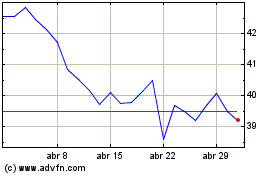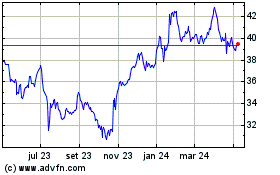Wireless Companies to Start Small With 5G Rollouts
24 Fevereiro 2018 - 11:29AM
Dow Jones News
By Drew FitzGerald
BARCELONA -- After a year of promising tests, wireless companies
are finally setting deadlines for the rollout of the next wave of
technology designed to revolutionize the way machines reach the
internet.
A handful of companies in the U.S. and Asia are expected to
start offering commercial fifth-generation, or 5G, service as soon
as this year. Their plans will dominate much of the agenda at the
coming week's Mobile World Congress, the annual confab here where
telecom companies and their suppliers meet to strike deals and
market themselves.
The optimistic timelines come with a caveat: Most 5G services
debuting this year will fall short of carriers' visions of what 5G
will ultimately be: cable-quality broadband linking billions of
gadgets over the air. Companies like AT&T Inc., Verizon
Communications Inc., Australia's Optus Pte. Ltd. and Finland's
Elisa Oyj will start small, using just one element of a package of
5G engineering standards that are still being written.
The "fixed wireless" service coming this year beams broadband
service into the home from outdoor antennae instead of bringing it
by cable. It won't offer the superfast connections between mobile
phones and other connected devices the new technology is designed
to serve, at least to start.
The high-tech holdup owes to basic infrastructure: 5G
technology, unlike past network upgrades planned around cellphones,
will need millions of new cellular radio antennae that have yet to
be installed. That gives an edge to landline companies with access
to telephone poles, though it will take time even then for them to
rig new radios along city streets.
Tests in Australia, China, Finland, Japan and South Korea have
led carriers to promise more 5G service by early 2019. Most plans
are a far cry from the type of service engineers say is possible in
a few years.
New 5G technology is supposed to boost bandwidth, allowing
cellphone users to download data at a gigabit per second or more, a
speed comparable to the top-tier internet packages that cable
companies offer today. The standards are also designed to make
networks react more quickly, which would allow driverless cars and
high-tech medical equipment to work online.
Equipment makers still need time to "seed the market" to make 5G
devices work, said Ted Rappaport, professor at New York
University's Tandon School of Engineering. Until phones and other
machines come equipped with capable chips, "fixed wireless is kind
of the lowest-hanging fruit."
It is hard to tell which devices will make the best use of 5G
technology until chip costs come down, said Michael Murphy, North
American technology chief for Nokia Corp.
"What's the killer app? Which ones make it and which ones don't,
we don't know," he said.
Verizon is among the companies starting at square one. It plans
to launch its first 5G service in Sacramento, Calif., after testing
the technology around 11 U.S. cities. But it says true mobile
service remains a few years down the road.
AT&T said it would offer fixed and mobile 5G service by the
end of 2018, though the first customers will likely be using the
service as a portable internet hot spot to do things like hook up
laptops.
"Think of this as a puck," AT&T Chief Executive Randall
Stephenson said in a recent investor call. "Because, really, the
thing that's going to cause 5G to go slow more than anything else,
it's just availability of handsets."
Write to Drew FitzGerald at andrew.fitzgerald@wsj.com
(END) Dow Jones Newswires
February 24, 2018 09:14 ET (14:14 GMT)
Copyright (c) 2018 Dow Jones & Company, Inc.
Verizon Communications (NYSE:VZ)
Gráfico Histórico do Ativo
De Mar 2024 até Abr 2024

Verizon Communications (NYSE:VZ)
Gráfico Histórico do Ativo
De Abr 2023 até Abr 2024
